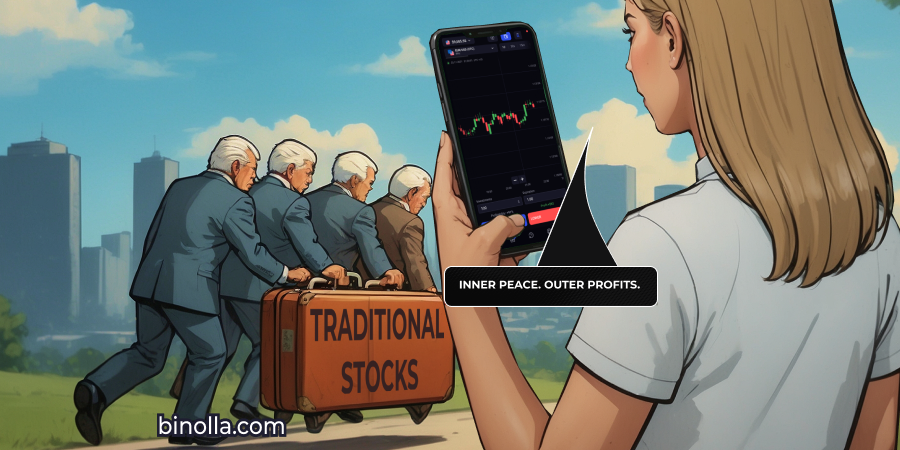Digital Options Trading: An Ultimate Guide for Beginners
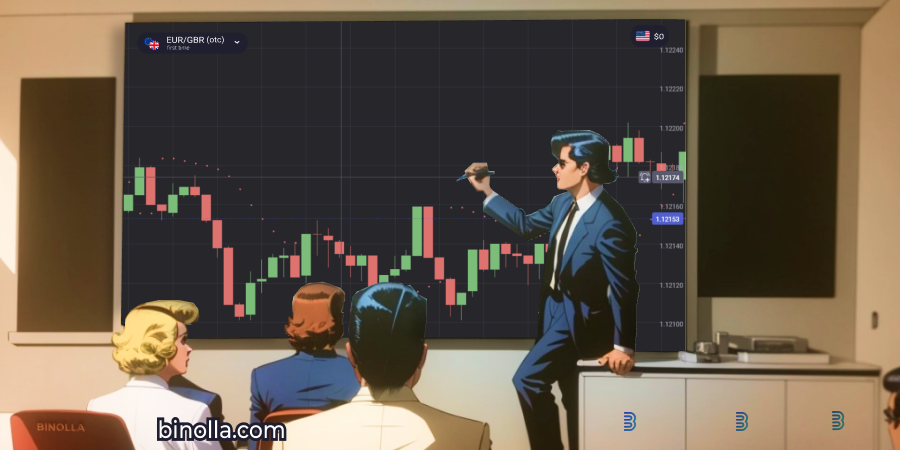
Digital options are fixed-payout and fixed-time contracts that are very simple to understand. When trading those options, you simply need to predict the direction of price fluctuations without setting exact goals. Fixed-payout contracts are based on various underlying assets, including Forex currency pairs, commodities, stocks, metals, and more. The difference between Forex and digital options is that you buy a contract instead of purchasing a currency pair directly. Digital options are considered the easiest way for beginner traders to familiarize themselves with the financial markets and start trading. If you want to learn more about what a digital option contract is, then you should read this article.
Contents
- 1 Digital Options Glossary
- 2 Digital Options Features
- 3 Digital Options Basics: A Video Tutorial for Trading These Contracts
- 4 How to Trade Digital Options: Fixed-Time Contracts Explained
- 5 Digital Options Trading Example
- 6 Forex CFD vs. Digital Options
- 7 Are Fixed-Time Contracts Suitable for You?
- 8 How to Choose Expiration Time?
- 9 Choosing Underlying Assets in Digital Options
- 10 When Is the Best Time to Trade Digital Options?
- 11 Risk Management in Fixed-Time Contracts Trading
- 12 Trading Strategies: Should I Use Them and Why?
- 13 Start trading digital options now!
- 14 Fixed-Time Contracts: Simple Strategies
- 15 Are Digital Options Scam or Not?
- 16 Key Tips for Digital Options Trading
- 17 How to Become a Successful Trader?
- 18 Final Words
- 19 FAQ
Digital Options Glossary
At the Money – describes a situation when the option expires with a null profit. The strike price is equal to the expiration one.
Expiration – a point in the future when the contract is executed and the results of the trade are calculated.
Higher – a type of contract that is bought when a trader assumes that the underlying asset’s expiration price will be higher than the strike price.
In the Money – describes a situation when the digital option is profitable for traders. For instance, a trader bought a Higher contract, and the underlying asset’s price at expiration is higher than the strike one.
Lower – a type of digital contract that traders buy when they think an underlying asset will expire with the strike price above that at the moment of expiration.
Out of the Money – this situation occurs when a trader loses money in digital options. If you buy a Higher option and the underlying asset goes down in price and closes below the strike price, the contract closes Out of the Money.
Strike Price – the price of the underlying asset at which a trader buys a digital contract.
Technical Analysis – this is the way for traders to predict future price fluctuations by using charts, technical indicators, patterns, etc. when they trade digital contracts.
Digital Options Features
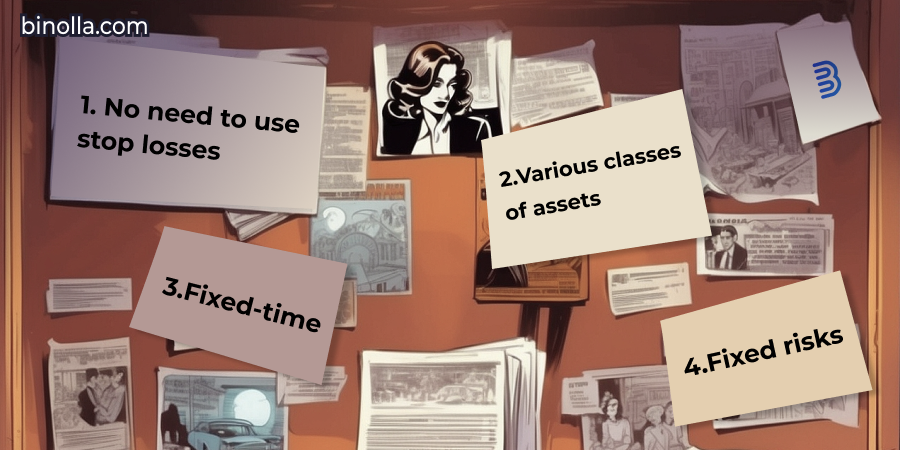
- Digital options have fixed risks, meaning your possible losses are limited to 100% of your single investment;
- Fixed-time digital options contracts have also fixed payouts, which means that you can calculate in advance your profits and, therefore, you don’t need to use those complex money management strategies;
- You can’t sell digital options at all. Those contracts have only a buy feature. Therefore, you can’t sell fixed-time contracts and you have to wait until expiration to see the results;
- Digital options can be traded on various classes of underlying assets, including FX currencies, commodities, stocks, metals, etc.
When it comes to the disadvantages of digital options trading, they are the following:
- You can’t cut your losses. If you were wrong in forecasting stock or currency price fluctuations, you will end up with a loss with no alternatives. You can’t sell the contract before expiration;
- Digital options are unregulated and they are prohibited in some countries;
- More expensive position size. When trading binary options, the minimum investment amount is $1.
Digital Options Basics: A Video Tutorial for Trading These Contracts
How to Trade Digital Options: Fixed-Time Contracts Explained
Fixed-time contracts are very simple when it comes to understanding how they work. To open a trade, you need to do the following:
- Conduct market analysis to understand whether the underlying asset price is to rise or plunge;
- Choose the amount of investment that you are going to put in a single digital options trade;
- Set expiration time;
- Choose Higher or Lower depending on your market analysis results;
- Wait for the expiry to occur to see the outcomes.
Now that you know how it works, we are going to provide you with some basic tactics.
Digital Options Trading Example
As an example of digital options trading, let’s assume you want to profit from EUR/USD’s fluctuations. The current price of the underlying asset is 1.0900. You think that it is going to rise in the next five minutes. To profit from this situation, you buy the Higher contract at 1.0900 as a strike price with a five-minute expiration. The profitability rate is 85%. You decide to invest $10.
EUR/USD grows in the following minutes and reaches 1.0905 by the moment of the contract’s expiration. This means that your forecasts were right and the trade closed with a profit. Apart from the $10 that goes back, you add $8.5 to your balance.
Another example is buying the Lower digital option contract. Let’s suppose EUR/USD is currently trading at 1.0900, and you think that the currency pair is going to plunge. To profit from this situation, you buy the Lower contract with a strike price of 1.0900 and a five-minute expiration. The investment amount is $10, with a profitability rate of 85%.
EUR/USD goes up in the following minutes and reaches 1.0901 by the moment of expiration. This means that your forecasts were unsuccessful, and you lost your investment.
Forex CFD vs. Digital Options
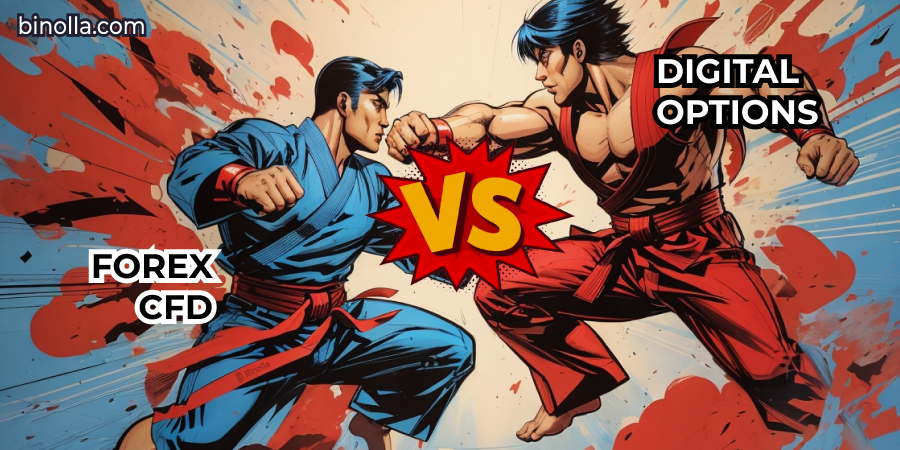
Binary options are not the only way to trade and try to profit from price volatility. Forex CFD trading is about buying and selling various types of assets and profiting from the price difference. While the goals of both are similar, digital contracts and Forex contracts (link: Digital Options vs. Forex CFD: What to Choose) are not the same. Here are some key points that make them different:
- When trading Forex CFD, the trades are not limited in time. You can buy EUR/USD, for instance, and hold this position for as much time as needed according to your strategy. In digital options, all deals are limited in time by expiration. This is an advantage of fixed-time contracts, as you do not need to think about how long to stay in the market.
- Losses are capped by the amount of investment in digital options, while in Forex you should take care of how to cut them on your own. Therefore, by trading fixed-time contracts, you simply need to predict the price direction.
- Huge payouts are another difference between Forex CFD and digital options trading. Each contract that you buy may bring you up to 85% of profitability, which is enormous compared to what you can earn on Forex for the same period of time.
- Another difference between Forex CFD trading, and digital options is spreads. Those are commissions that the broker takes for your trading activities when you buy or sell assets. While they are relevant for Forex CFDs and take a part of your eventual profit, there are no spreads in digital options at all, as all commissions are already included and you can see your pure payout from each trade.
- Fixed-time contracts do not have any leverage, as you simply don’t need them. With a huge up to 85% profitability, you can adjust your investment in order to earn more. When it comes to Forex CFD, in order to start with smaller deposits and earn some decent amounts, traders often accept leverage. Therefore, they have to be even more careful when planning their budget.
- When trading digital options, you don’t need to calculate your eventual profits as well as the risk/reward ratio. The only thing that you should take care of is to have a strategy that will allow you to close more profitable trades. And this is one of the key differences between Forex and digital options.
Are Fixed-Time Contracts Suitable for You?
Thinking about whether to start trading digital options or not, you should keep in mind the following ideas:
- Fixed-payout contracts are very simple to understand. This is one of the best ways for beginners to start their journey in the financial markets. All you need to do is predict the price direction and choose between only two types of contracts: Higher or Lower
- Digital Options do not require as much knowledge as other financial instruments. Therefore, you can jumpstart those contracts and diversify them with other assets later.
- Those contracts have high payouts. If you are looking for a way to earn up to 85% per trade, then digital options should definitely at least catch your eye.
- When trading fixed-payout contracts, you can focus on market predictions instead of thinking about where to close the deal or how to cut losses. This makes digital options the easiest way to trade on financial markets.
How to Choose Expiration Time?

Choosing expiry in digital options is the second key task for a trader after forecasting price fluctuations. It is important to think about what type of trader you are. Those who are ready to make fast decisions can choose any type of expiration, from 15 seconds to even several hours.
Scalping (5-30 seconds) is suitable for those traders with reliable strategies and the ability to quickly react to minor market changes, as well as for those who like to have quick trading results. If you feel like you are ready for this environment, you can try scalping.
Those who need more time to think normally choose digital options with an expiration time of one minute to one hour. They do not require speed during the decision-making process but, instead, allow you to spend more time thinking about further price direction.
When picking the expiration date for a particular trade, you should also consider current market trends. When trading along the trend, it is better to pick digital options with expiration from one to four hours, while if you are looking for some correctional moves, which are normally short in time, it is better to buy options with expiration from 15 seconds to 30 minutes.
Choosing Underlying Assets in Digital Options
Fixed-time contracts are based on various assets, including currencies, stocks, commodities, metals, etc. Choosing an underlying asset randomly for each particular trade is not a good idea. To pick an asset for trading, you should consider the following aspects:
- Learn more about economic data (Link to: Introduction to Fundamental Analysis) that can impact a particular currency. To do that, you can look through the macroeconomic calendar. The list of the most important events always includes interest rates, central banks’ or financial sector executives’ comments, GDP data, PMI indexes, inflation, labor market statistics, etc.
- Apply various technical analysis tools and trading strategies (Trendline: How to Draw and Use It). This will allow you to see whether you can use them in your trading routine. While technical analysis and most strategies are universal and suit all financial instruments, not all of them are applicable to a particular asset.
- Think about the time you are ready to devote to trading. To choose a particular underlying asset (Link to: How to Choose an Underlying Asset for Trading), you should consider your time zone and compare it to the main trading sessions. Keep in mind that most currencies have the strongest volatility during their geographical session, while they become less “active” during other sessions. Since digital options profits are less dependent on volatility, you can equally try a “calm” session and use range strategies.
When Is the Best Time to Trade Digital Options?

Thinking about the best time to trade digital options, there are many things to consider. First, you should keep in mind that while Forex is a 24/5 market, all trading activities are divided into several sessions:
- Tokyo. The local stock exchange operates Monday through Friday from 9-11:30 a.m. and then from 12:30-3 p.m. Japan Standard Time (GMT+9);
- Sydney. The local exchange is available Monday through Friday 10:15 a.m.-4:15 p.m., Australian Eastern Daylight Time (GMT+11);
- London. The exchange is available Monday through Friday 8 a.m.-noon and 12:02 to 4:30 p.m. GMT;
- New York. The exchange is available Monday through Friday 12 pm to 8 pm GMT.
All those sessions have overlaps, which means that one or two hours before the previous one closes, the next one starts operating. Therefore, Forex trading is seamless throughout the whole business week, and this is one of the advantages of picking currencies as underlying assets.
Here are some recommendations about the best time to buy fixed-time digital options contracts during the week (London time):
- Mondays afternoons. While Monday morning is not the best time to trade as the activity is very low, the afternoon changes the situation as markets warm up. While the liquidity is still far from its peak during this period, you can expect some interesting price movements.
- Sessions overlaps. The intervals between two sessions, when they overlap, are also a great time to trade. This is due to the liquidity crossover. While traders and investors from the previous session are still active, new participants arrive to increase volumes.
- Tuesday through Thursday. The liquidity reaches its peak three days a week. Therefore, you can expect strong trend movements and profit from them when buying digital options.
- Trading sessions. We have already mentioned that currencies perform better during their own sessions. EUR, GBP, and CHF can be traded during the London session, while AUD or NZD have better performance in Sydney.
Apart from the best time to trade digital options, there are moments when you should better avoid buying fixed-time contracts. They are the following:
- Late Friday-Early Monday. Markets’ activities slow down on Friday afternoon and remain minor during the weekend. Moreover, on Monday the liquidity is still mediocre, which means that you should wait until Monday afternoon to see the activity rise.
- National and international holidays. Banks are closed during national and international holidays and, therefore, the liquidity will be much lower than expected. Even if you feel the urge to buy a couple of digital options contracts during this period, this is not a good idea as the volatility may be too low and the fluctuations are less predictable.
- Asian session. If you are not looking to buy contracts for AUD, NZD, or JPY, it is better to avoid trading other major currencies during this time.
Trading during major macroeconomic news can have both pros and cons. While important news may add volatility, it may also bring uncertainty, break some technical chart patterns, or provide you with wrong indicator signals. Therefore, trading digital options on the news always has two sides. The one is that you can have profits on one of those strong movements that are awakened by key data. The other is that you never know whether a market reaction will have a logical explanation or whether this reaction will be at all.
Risk Management in Fixed-Time Contracts Trading

Digital options are risky like any other financial instrument (even though those risks are partially limited by the nature of contracts). Therefore, to trade profitably, you should also learn about risk management and tactics that you can use to decrease your losses.
Regardless of your trading strategy or your current trading skills, risk and money management (link: 10 Ways to Manage your Risks in Trading) should be the first thing you think about before even placing your first trade. Here are some basic risk management rules that you can follow to improve your results:
- The amount of investment. It determines how much you are willing to risk per trade. According to the general money management concept, it is recommended to put 1-2% of your whole deposit amount at risk per trade. Therefore, if your balance is $100, the investment should not exceed $1-2. Experienced traders sometimes increase this amount to 5% per trade.
- Think about your trading budget. When trading time-fixed contracts, you should also keep in mind that you should not deposit more than you can afford. Losses are an integral part of trading. Therefore, you should not deposit more than you can lose.
- Diversify (link: Diversification in Trading) your trading portfolio. To decrease risks, skilled traders sometimes buy several digital options with various underlying assets. This strategy is similar to an investment portfolio, where different assets may not only decrease your overall losses but also allow you to turn losses into profits in general.
Trading Strategies: Should I Use Them and Why?
Professionals always use strategies to predict price fluctuations. This allows them to be more disciplined and bring an element of systematization into their trading routine. Simply put, if you have a strategy, all decisions that you make are explained by a particular system.
Each strategy (or almost each) includes an analysis tool (or several ones), which allows traders to follow current trends, find price corrections, and even see entry points. The most popular types of tools include:
- trend indicators (link: Top 5 Trend Indicators in Trading);
- oscillators (link: Top 5 Momentum Indicators in Trading);
- drawing tools;
- price patterns (Price Patterns in Trading);
- Japanese candlestick patterns (link: Candlestick Charts: The Most Popular Reversal Patterns).
Strategies are not only about receiving signals from markets. They also have a psychological impact. They act like a compass. Imagine that you have lost yourself in the woods. When you turn around, you see the same landscape, and you can start panicking. Having a compass, at least, will allow you to find your way out of the woods.
When you look at naked charts without having a strategy, you don’t understand what is going on and where to buy a particular fixed-time contract. With a strategy, you have an understanding of how you can benefit from this situation.
Before you create your own strategy or apply any of the existing ones, you should keep in mind that there are no win-win tactics. Each strategy may work under certain conditions and give you a number of false signals. Moreover, trading with strategies resides in your subjective opinion about the current market situation, which may be another reason for losses when you trade digital contracts
Therefore, before even starting to use a particular strategy, you should be prepared for the fact that not all the signals that it provides will lead to profits. By learning more about your strategy’s profitability, you can calculate your future profits and predict your balance sheet in advance over time.
Fixed-Time Contracts: Simple Strategies
Buying Higher or Lower depends on your market perception. Traders use various tactics to turn the balance in their favor. Here are some basic strategies that you can apply when trading those contracts.
MA Crossover
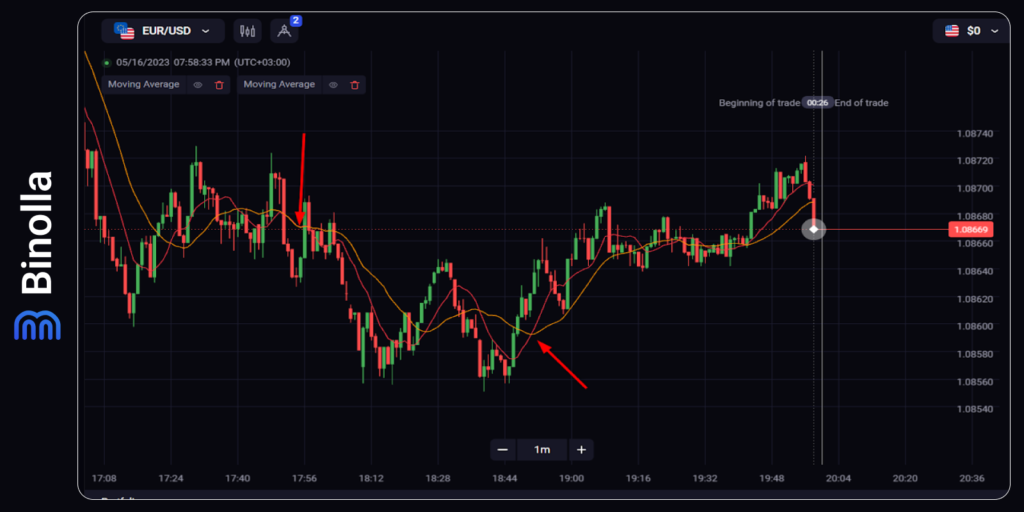
This is a classic strategy that uses two moving averages to predict market reverses. Keep in mind that both should have different periods. Otherwise, they simply overlap each other. The crossover is a signal for traders to buy Higher and Lower options.
If the crossover takes place below the price, traders can buy Higher contracts. When this crossover happens above the price, traders purchase Lower options. Before applying these tactics, we suggest learning more about the moving average indicator (link to Moving Average).
Support and Resistance Rejection
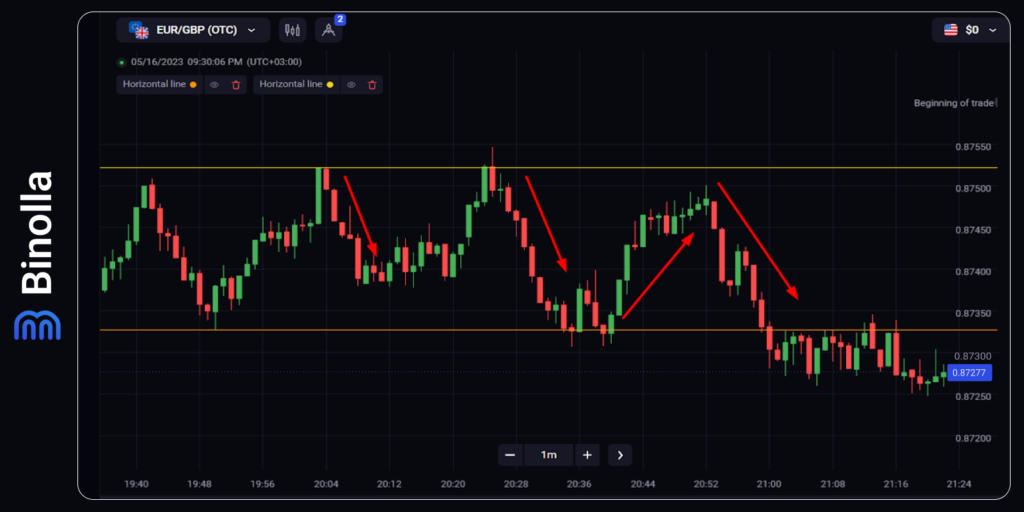
Sometimes you don’t even need a technical indicator to predict price fluctuations. By simply applying support and resistance lines to the chart, you have a powerful tool to forecast future asset movements. If the price stays within a range, you can use this situation to trade from both boundaries. The image above demonstrates how this strategy works in digital contracts.
Once the price bounces off the upper boundary (resistance), you can buy the Lower option, while after the asset jumps off support, you can buy the Higher option. Before you start using this strategy, it would be a good idea to refresh your memory about support and resistance levels (link to: Support and Resistance Levels: How to Use Them).
Shooting Star Candlestick
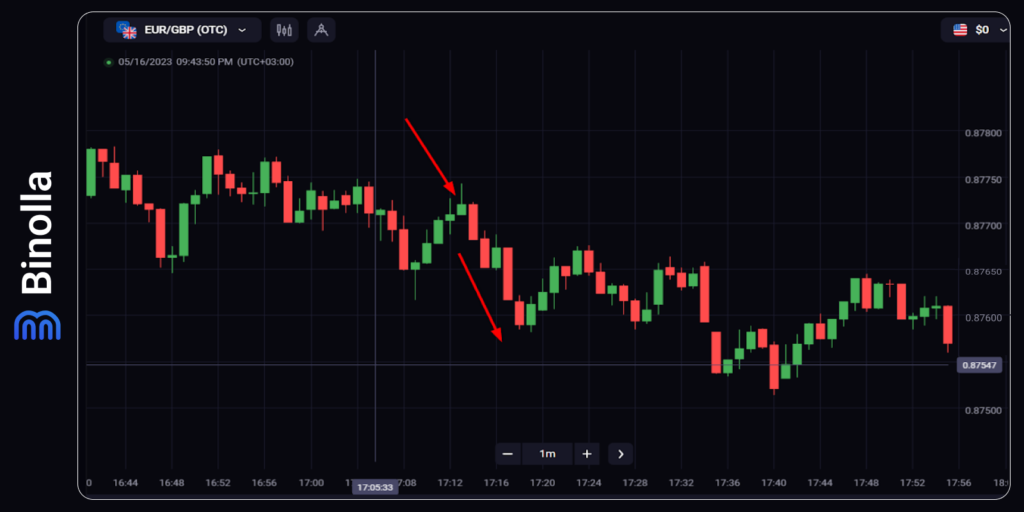
The Shooting Star pattern belongs to price action, which, in turn, is based on Japanese candlesticks. This pattern has a long upper wick and a relatively small body. Once the Shooting Star candlestick closes, traders can buy a Lower option. As you can see, the underlying asset goes down after this one is formed. To learn more about those patterns, we advise you to look through Candlestick Charts: The Most Popular Reversal Patterns.
Following News
One of the simplest strategies when trading digital options is buying contracts after important news releases. Normally, markets react to those events with massive volatility growth, which, in turn, allows you to join local trends. One of the benefits of such an approach is that you don’t need anything to add to the charts at all. The idea is to follow the momentum and try to join the market trend until it dries out. Find out more about news trading strategies here (link to: News Trading Basics).
Are Digital Options Scam or Not?
Sometimes you may come across the idea that digital options are a scam and you can’t earn money when trading those option contracts. This is not true, as those fixed-time contracts are totally legal and are not prohibited. Even in the United States, with its strict regulatory rules, digital contracts are allowed.
Why may traders think that a digital option is a scam?
- Unrealistic expectations of high profits. There are plenty of stories of traders who have made millions trading fixed-time contracts. This creates the wrong perception of financial markets among beginners. They think that if there are success stories, then they can also become millionaires with a snap. The reality is totally different. To become a successful trader, you need to make a long path that includes knowledge, practice, and even losses that will inevitably accompany your trading routine;
- Lack of understanding of a digital option. It is a common belief that fixed-time contracts are very simple. However, this simplicity is not about making profits. Digital options are very straightforward because the mechanism of such derivatives is simplified as compared to Forex CFD, for instance. However, when it comes to other aspects of trading, such as predicting price direction or money management, you will have to conduct your analysis and plan the amount of investments in order to succeed;
- Trading Complexity. Once a trader faces difficulties and loses money, they start thinking that digital options are fraudulent. However, losing money in the beginning is normal as you are still in the studying phase. Once you learn more about trading, build your strategy, and pick a reliable money management approach, you will be able to start earning money. Our experts will provide you with all the necessary information about trading.
Key Tips for Digital Options Trading
Before you start your fixed-time contract journey, there are some important tips to learn:
- Trade underlying assets that you are comfortable with. Before placing your first trade, it is a good idea to think about what exact currency pair you like. Your choice may also depend on your timezone. If you are comfortable with trading during the European or American session, it is a good idea to pick assets from those areas.
- Keep an eye on your budget. Traders should always think about how much they invest in a single trade. Putting it all at risk is the fastest way to lose the whole deposit. Therefore, you should plan in advance how much you can afford to lose by buying a single contract. This approach will allow you to plan your trading budget wisely.
- Get the most out of the demo account. Whether you are a novice or a skilled trader, it would be a good idea to start on the demo. This will allow you to learn more about the platform as well as work with your strategy before putting real money at risk.
- Stick to your strategy. All your market decisions should go hand in hand with your strategy. Otherwise, you risk making wrong steps that will lead to losses.
How to Become a Successful Trader?

If you want to avoid those “hard lessons” of trading, go through the points below that will help you better understand what to do to become a successful trader:
- Do not treat trading like a game. While trading is a game, this is not a game of betting, as many beginners may perceive it. This is rather a game of minds where you need to apply effort in order to profit. Therefore, before stepping into trading, you should be prepared and have enough knowledge to predict price fluctuations and protect your balance from excessive risks;
- Understand markets and how they work. Digital options trading is based on underlying assets. Therefore, you need to understand how a particular financial market works. In general, the idea of markets is to buy cheaper and sell once the price of the asset becomes more expensive. When it comes to a digital option, your main goal here is to buy Higher contracts when the price is relatively low and buy Lower contracts when you think that the asset is overbought;
- Determine market conditions. When you are dealing with fixed-time options, you can use technical analysis to predict future price directions. This analysis is based on charts, price patterns, as well as various indicators that allow you to see the current trend, predict price reversals, or even evaluate the strength of a particular market movement;
- Know where and when to enter the market. One of the biggest issues in trading is finding good entry points. This is where the previous recommendation comes into play. You should use technical analysis or even a fundamental approach to understand when and where to place your trade. In other words, you should understand whether the future price will be over or below the strike price of the underlying asset and place a trade accordingly to your market perception;
- Make a risk appetite assessment. This is a common problem for many beginners to have excessive risk appetites or unrealistic expectations about trading or possible profits. While investing more in a single trade may bring you higher profits, you should never forget about the risks that accompany you at any moment of your trading career. The idea is to find a balance between your trading expectations and risks that you can afford in each particular trade. Even if you are sure that the price of the underlying asset is going to surge from its strike price, you should always have a plan B in mind, meaning that if something goes wrong, your losses will not ruin your trading balance;
- Use a trading strategy. Having a strategy is 50% of success in trading. While there is no guarantee that it will provide you with 100% perfect entry points, it will help you stay in control and systematize your trading routine. It is a lot easier for traders to rely on a system with strict rules of engagement than to try to use random approaches in each particular trade;
- Stay in control of your emotions. To become a successful trader, you should never let your emotions control your trading routine. Avoid greed, fears, thrills, and all other emotions that may affect your decisions.
Final Words
Digital contracts are the fastest way for beginners to step into trading in financial markets. When trading digital options, your main task is to understand whether the price is going to surge or plunge. Those digital contracts are very simple to understand as they have only two possible outcomes. You either close a trade with a profit or lose money.
A digital option is a type of contract that is traded with underlying assets. Therefore, you don’t buy a currency pair directly but rather a contract for the currency pair. While it may sound difficult, a digital option is a very simple type of derivative.
FAQ

How Does a Digital Option Work?
A digital option is a form of financial contract that allows you to predict whether the price of an underlying asset is going to grow or plunge. At Binolla, you can buy two types of contracts – Higher or Lower. If you buy a Higher option, you expect the price to go upwards, while by purchasing a Lower contract, you predict the price to go in the opposite direction.
What Are Examples of a Digital Option?
Assume that you think that EUR/USD is going to rise and reach 1.1000 from the current 1.0996 level. You buy a Higher option with a strike price of 1.0996 and a minute expiration. If the price of the asset hits the expected level by the moment of expiration or goes above 1.1000, your option closes with a profit.
Are Digital Options a Form of Gambling?
No, they are not. Gambling is about chance, even if players sometimes use some strategies. The outcome is defined by chance, while in trading, outer factors influence the price, meaning you can make data-driven predictions.
Can I Trade Digital Options for a Living?
Yes, you can. However, you need to learn more about those digital contracts as well as study technical analysis, various techniques, and money management. You should also create a strategy that will allow you to find good entry points.
